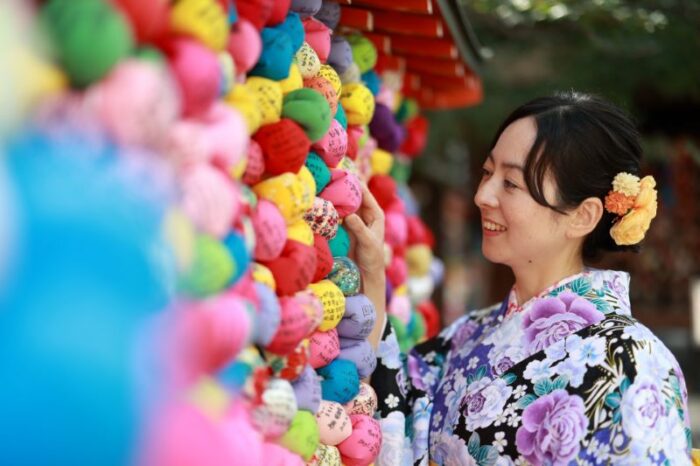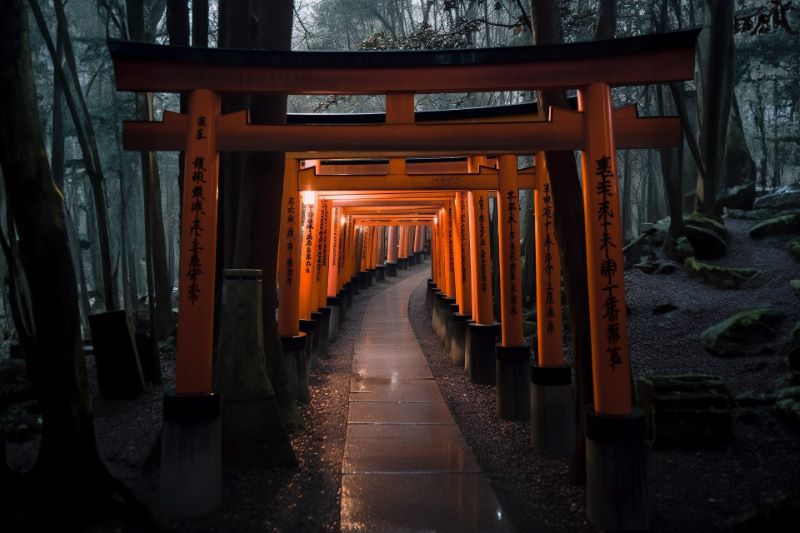Embarking on a cultural journey to mark the new year, visitors flock to Kyoto for Hatsumode, a sacred custom that marks the first shrine or temple visit of the New Year. This cherished tradition, filled with hope and optimism, allows individuals to welcome the year with positivity.

From ringing bells at temples on December 31st to queuing up for prayers on January 1st, Kyoto offers a stack of shrines and temples to choose from, including the renowned Yasaka-jinja Shrine, Heian-jingu Shrine, and Fushimi-Inari-Taisha Shrine with its stunning tori gates.
Key Takeaways
- Hatsumode is the first shrine or temple visit of the New Year in Japan, with great cultural and religious significance.
- Visitors participate in various customs and rituals, such as ringing bells to bid farewell to the old year and praying for a fruitful year ahead.
- Fushimi Inari Taisha is a must-visit shrine in Kyoto known for its mesmerizing tori gates and serene atmosphere.
- Fortune-telling, through omikuji paper fortunes, adds a unique and insightful aspect to the Hatsumode experience.
History and Significance of Hatsumode

Hatsumode holds a significant place in Japanese culture as it marks the sacred tradition of the first shrine or temple visit of the New Year. This tradition is deeply rooted in history and has been observed for centuries.
Hatsumode is not only a religious practice but also a cultural experience that brings people together to celebrate and reflect on the past year while looking forward to the future. It is a time for individuals to pray for good fortune, health, and happiness in the coming year. Many people believe that their wishes will come true if they visit a shrine or temple during this time.
Hatsumode is not just a ritual; it is a journey of hope, renewal, and spiritual connection.
Traditional Customs and Rituals

Visitors eagerly participate in various traditional customs and rituals during their shrine or temple visits in Kyoto.
These customs and rituals add a touch of spirituality and cultural richness to the experience. One popular custom is the ringing of bells at temples on December 31st, symbolizing the bidding farewell to the old year. On January 1st, people queue up to pray for a fruitful year ahead, marking the transition from the old to the new.
Another interesting tradition is fortune-telling, where visitors pay ¥100 for omikuji paper fortunes, ranging from great blessings to great curses.
This activity provides a symbolic start to the New Year and is both fun and insightful. To make the writing more engaging, here is a table highlighting some popular shrines and temples for hatsumode visits in Kyoto:
| Shrine/Temple | Location |
|---|---|
| Fushimi Inari Taisha | Fushimi-ku, Kyoto |
| Jishu Shrine | Higashiyama-ku, Kyoto |
| Kitano Tenmangū | Kita-ku, Kyoto |
| Shimogamo Shrine | Sakyo-ku, Kyoto |
| Kamigamo Shrine | Kita-ku, Kyoto |
These destinations are known for their serene ambiance and cultural significance, making them ideal for a memorable hatsumode experience.
Must-Visit Shrines and Temples in Kyoto

Fushimi Inari Taisha stands out among other shrines and temples in Kyoto with its mesmerizing tori gates, making it a must-visit destination. Here are four reasons why this shrine is so captivating:
- Endless Path of Gates: As you enter the shrine, you will be greeted by thousands of vibrant red tori gates, forming a breathtaking pathway that stretches up the mountain. Walking through this tunnel of gates creates a sense of awe and wonder.
- Serene Surroundings: The shrine is nestled amidst the tranquil forests of Mount Inari, providing a peaceful and serene atmosphere. The sound of rustling leaves and chirping birds adds to the overall sense of tranquility.
- Scenic Hiking Trails: Fushimi Inari Taisha offers several hiking trails that lead to various smaller shrines and viewpoints. As you hike up the mountain, you will be rewarded with stunning vistas of Kyoto city and the surrounding countryside.
- Cultural Significance: Fushimi Inari Taisha is dedicated to the Shinto god of rice and agriculture. It holds great importance for locals, who often visit to pray for good fortune and success in their endeavors.
Visiting Fushimi Inari Taisha is not just a sightseeing experience, but a cultural journey filled with beauty, spirituality, and a deep connection to Japan’s traditions.
Fortune-Telling and Omikuji Experience
Fortune-telling at Fushimi Inari Taisha offers visitors a chance to pay ¥100 for omikuji paper fortunes, providing them with a symbolic start to the New Year. This fun and insightful activity allows people to learn about their fortune for the upcoming year. The omikuji fortunes range from Great blessing to Great curse, giving individuals a glimpse into what the future may hold. To further engage the audience, here is a table showcasing the different omikuji outcomes:
| Omikuji Outcome | Meaning |
|---|---|
| Dai-kichi | Great blessing |
| Kichi | Blessing |
| Chu-kichi | Middle blessing |
| Sho-kichi | Small blessing |
| Sue-kichi | Ending blessing |
With this unique experience, visitors can start the New Year with hope and optimism, as they embrace the ancient tradition of fortune-telling at Fushimi Inari Taisha.
Embracing Serenity: Hatsumode in Kyoto

Visitors to the top three grand shrines in Kyoto can participate in the sacred tradition of Hatsumode. This allows them to embrace a sense of peace and renewal as they welcome the New Year. This cultural journey of serenity is a cherished custom in Japan, marking the first shrine or temple visit of the year.
Taking place between New Year’s Eve and January 3rd, Hatsumode symbolizes bidding farewell to the old year and embracing the new one with hope and optimism. People line up for hours in advance, eagerly waiting their turn to pray for a fruitful year.
The top three grand shrines for Hatsumode visits in Kyoto are Yasaka-jinja Shrine, Heian-jingu Shrine, and Fushimi-Inari-Taisha Shrine. The latter stands out with its iconic tori gates.
Participating in Hatsumode is not only a joyful experience but also a chance to start the year on a positive note. It allows for connecting with tradition and finding inner peace.
Frequently Asked Questions
How Long Does the Average Wait Time for Hatsumode at Popular Shrines and Temples in Kyoto?
The average wait time for Hatsumode at popular shrines and temples in Kyoto can be several hours. Visitors often line up in advance to participate in this sacred tradition, embracing the New Year with hope and serenity.
What Is the Significance of Ringing Bells at Temples on December 31st?
Ringing bells at temples on December 31st is a significant tradition in Japan. It symbolizes bidding farewell to the old year and welcoming the New Year with positive energy. People participate in this ritual to bring luck and prosperity for the coming year.
Are There Any Specific Rituals or Customs That Are Unique to Hatsumode in Kyoto?
There are several unique rituals and customs that are specific to Hatsumode in Kyoto. Some examples include visiting popular shrines like Fushimi Inari Taisha and participating in fortune-telling activities with omikuji paper fortunes.
Can You Explain the Meaning Behind the Different Levels of Omikuji Fortune Papers?
The different levels of omikuji fortune papers in Hatsumode represent a range of blessings and curses. They provide a symbolic start to the New Year and offer a fun and insightful activity for participants.
Are There Any Specific Recommendations for Experiencing Serenity During Hatsumode in Kyoto?
There are several ways to experience serenity during Hatsumode in Kyoto. One recommendation is to visit Fushimi Inari Taisha, known for its tranquil atmosphere and stunning tori gates.
The Sum Up
To sum it up, Hatsumode in Kyoto offers a cultural journey of serenity. Visitors can enjoy the rich traditions and customs of Japan. The historical significance of the ritual and the must-visit shrines and temples provide something for everyone to experience and enjoy.
The omikuji fortune-telling and the top three grand shrines add an element of excitement and anticipation to the New Year. Overall, Hatsumode in Kyoto is a beautiful way to embrace serenity and start the year with hope and positivity.




